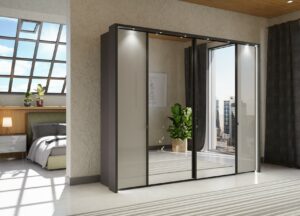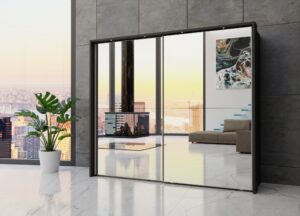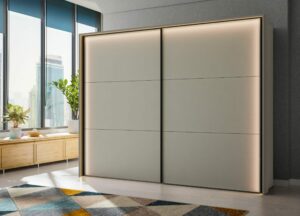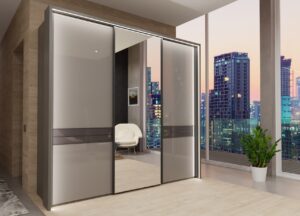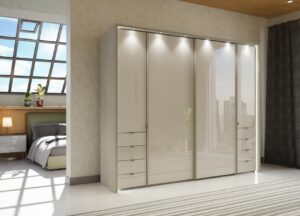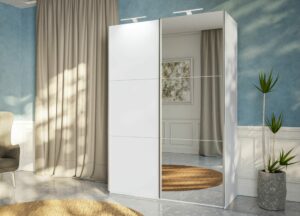Before you purchase a wardrobe, establish exactly where in your room it’s going to be placed. Measure your wall space and your floor space to make sure that you have your dimensions 100% correct – you can always request the assistance of a professional if you’re unsure.
Ideally, choosing a larger wardrobe is favourable because, let’s admit it, you can never have too much storage space! However, you must also be practical. Consider whether there will be sufficient clearance for doors to open easily and assess how much space you’d like to have for comfortable movement. Balancing ample storage with practicality and free space to move around is key.
The Best Hinged Sliding Wardrobe Sizes
Hinged wardrobes have their front doors fixed with hinges so that they can be pulled open for easy access to your belongings.
- The typical standard depth of a hinged wardrobe is around 60 cm. However, many wardrobe manufacturers offer depth options ranging from 50 cm to 70 cm. If you have a very small room, the 50 cm option may be the most suitable for your space, as it provides a more space-efficient design.
- The height of the wardrobe is often determined by the lintel level of the doors, which is usually around 210-220 cm. Alternatively, you can choose a full-height wardrobe by using the space from the floor to the ceiling.
- As a general guideline, the width of a door panel on a wardrobe should not exceed 60 cm. Going beyond this width may lead to a door that is too heavy for the hinges to support effectively.
The Best Sliding Wardrobe Sizes
The panels of these wardrobes slide on tracks and are perfect for tighter spaces. That’s why they are called sliding wardrobes.
- The typical depth of a sliding-door wardrobe is approximately 64 cm, which includes a running track of about 4 cm to enable smooth movement of the sliding panels. The spacing of the sliding panels is crucial to prevent your clothes from getting stuck and to ensure easy access to your wardrobe’s contents.
- Each panel of a sliding wardrobe should generally not exceed a width of 120 cm. Exceeding this width may make the panels too heavy to glide open and close with ease, potentially causing operational issues.
Here are a few examples of ultimately stylish sliding-door wardrobes:
The Best Men’s Wardrobe Sizes
Men generally don’t need as much height for hanging their garments as women do, hence the division between “men and women” wardrobes.
- For storing shirts, jackets, and folded pants in a wardrobe, it’s recommended that the minimum height of each hanging section be at least 100 cm. This allows for proper storage and access to these types of clothing items.
- It’s advisable to maintain a gap of at least 7 cm between the rail and the top of the wardrobe. This space allows for easy addition and removal of hangers and ensures practical functionality for your wardrobe.
- Given that bulky coats are a common addition to men’s wardrobes, it’s important to ensure a greater depth, typically ranging from 70-76 cm. This depth helps prevent the sleeves of a coat from getting stuck within the wardrobe’s door panels and ensures more practical storage.
An example of the interior of an ideal men’s wardrobe:
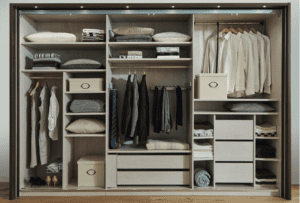
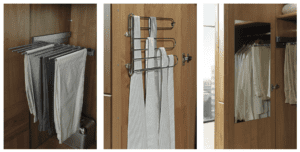
The Best Women’s Wardrobe Sizes
When long evening dresses and ballgowns are part of your wardrobe, the height of the wardrobe is a crucial element to consider when selecting the right-sized design. These types of clothing items require taller hanging sections to prevent them from touching the bottom and getting wrinkled.
- When it comes to hanging women’s garments like gowns or full-length dresses, the vertical clearance of the hanger section should typically average between 165-182 cm. Some wardrobe manufacturers may offer the option to adjust the height to suit your individual preferences and height, providing more flexibility in wardrobe design.
- Hang blouses, formal tops, skirts, or folded pants in a smaller section that features a height of 100 cm.
Idea: include drawers or open shelves for keeping folded items, shoes, and hats. There should be a gap of at least 30-55 cm between each shelf.
The Best Child’s Wardrobe Sizes
Teeny tiny clothes need less space, however, at the rate kids grow, investing in a larger wardrobe is an economic practice. A larger wardrobe can be used well into adulthood.
For your reference, sizing for a kid’s wardrobe is as follows:
- Install poles for hanging clothes by dividing the vertical length of the wardrobe into three sections of about 70 cm each. This way, you can hang plenty of smaller-sized garments in one compartment. You can remove the lower poles as your child grows.
- Add drawers that measure between 15 and 35 cm to accommodate folded clothes as well as accessories, toys, or books.
Tip: open shelves are great for storing items that need to be piled, such as nappies, towels, linen, and shoes. Choose open shelves that are plus/minus 30 cm apart.
The Best Walk-in Closet Sizes

Image credit: Artur Mitroshkin
When it comes to walk-in wardrobes, you’re spoilt for choice and the size of your room will determine its final dimensions. You will want to make sure that:
- There is enough room for you to manoeuvre between shelves and clothes.
- That you can comfortably access your wardrobe.
Good advice If the walk-in closet is narrow, opt for sliding panels as doors, as they are an excellent space-saving solution.
Knowing how to select the appropriate wardrobe size may not be a skill to build a career with, but it certainly proves useful when you aim to combine practicality and style for comfortable living.

